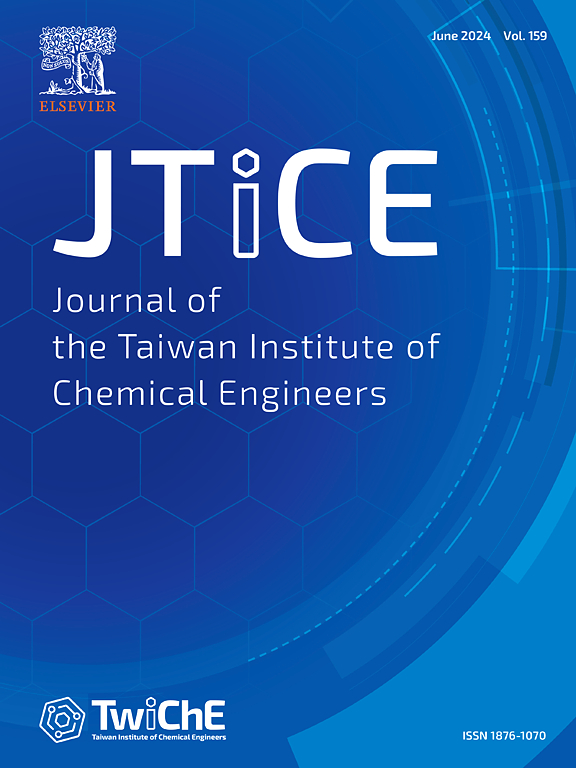纳米层状MoSSe/氮掺杂RGO/镍泡沫电极的合成及电容性能研究
IF 6.3
3区 工程技术
Q1 ENGINEERING, CHEMICAL
Journal of the Taiwan Institute of Chemical Engineers
Pub Date : 2025-07-16
DOI:10.1016/j.jtice.2025.106295
引用次数: 0
摘要
碳同素异形体纳米复合材料与过渡金属硫族化合物在新一代储能装置中引起了广泛的关注。本研究采用无粘结剂的简单水热方法,在泡沫镍(Ni-foam)表面合成了纳米层状硫化硒化钼(MoSSe)与氮掺杂还原氧化石墨烯(N-RGO),旨在为硬币电池设计的高性能超级电容器开发独特的电极。方法通过全面的结构和形态分析,证明在泡沫镍表面形成了MoSSe/N-RGO纳米复合材料。通过恒流充放电(GCD)、循环伏安(CV)和电化学阻抗谱对MoSSe/N-RGO@Ni-foam储能电极的电容性能和电化学性能进行了评价。MoSSe/N-RGO@Ni-foam电极表现出类似电池的特性,在CV曲线扫描速率为1 mV/s时,比电容显著提高至1113 F/g。此外,基于MoSSe/N-RGO@Ni-foam电极的超级电容器在1 a /g时的比电容为239.3 F/g,具有良好的循环稳定性(循环5000次后保持率为62.9%),最大功率密度为9600 W/kg,最大能量密度为47.85 Wh/kg。结果表明,MoSSe/N-RGO@Ni-foam电极作为一种新型的极具潜力的超级电容器电活性材料,具有良好的性能。本文章由计算机程序翻译,如有差异,请以英文原文为准。

Synthesis and capacitive properties of nano-layered MoSSe/Nitrogen-doped RGO/Nickel foam electrode for enhanced-performance battery-like supercapacitors with coin cell design
Background
Carbon allotropes-based nanocomposites with transition metal chalcogenides attract much interest in contriving unique electrodes for new generation energy storage devices. In this study, a simple hydrothermal method with binder-free was used to synthesize nano-layered molybdenum sulfide selenide (MoSSe) combined with nitrogen-doped reduced graphene oxide (N-RGO) on nickel foam (Ni-foam), aiming to develop unique electrode for enhanced-performance supercapacitors with coin cell design.
Methods
Comprehensive structural and morphological analyses were conducted to prove the formation of the nano-layered MoSSe/N-RGO nanocomposite on Ni-foam. The capacitive and electrochemical performances of the MoSSe/N-RGO@Ni-foam electrode for energy storage applications were then evaluated through galvanostatic charge/discharge (GCD), cyclic voltammetry (CV), and electrochemical impedance spectroscopy.
Significant findings
The MoSSe/N-RGO@Ni-foam electrode demonstrated battery-like characteristics with a significantly enhanced specific capacitance of 1113 F/g at a scan rate of 1 mV/s from CV curves. In addition, the MoSSe/N-RGO@Ni-foam electrode-based supercapacitor exhibited a well enough specific capacitance of 239.3 F/g at 1 A/g from GCD curves, good cyclic stability (62.9% retention after 5000 cycles), a maximum power density of 9600 W/kg, and a maximum energy density of 47.85 Wh/kg. The obtained results show the remarkable performance of the MoSSe/N-RGO@Ni-foam electrode as a new potential electroactive material for supercapacitors.
求助全文
通过发布文献求助,成功后即可免费获取论文全文。
去求助
来源期刊
CiteScore
9.10
自引率
14.00%
发文量
362
审稿时长
35 days
期刊介绍:
Journal of the Taiwan Institute of Chemical Engineers (formerly known as Journal of the Chinese Institute of Chemical Engineers) publishes original works, from fundamental principles to practical applications, in the broad field of chemical engineering with special focus on three aspects: Chemical and Biomolecular Science and Technology, Energy and Environmental Science and Technology, and Materials Science and Technology. Authors should choose for their manuscript an appropriate aspect section and a few related classifications when submitting to the journal online.

 求助内容:
求助内容: 应助结果提醒方式:
应助结果提醒方式:


